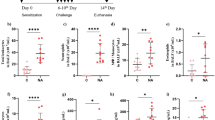Abstract
Carrageenan of different concentrations was injected into the 6-day-old air pouch in mice. It was found that 12 mg carrageenan caused a significant increase of plasma and exudate corticosterone levels at 24 h, while 1 and 3 mg carrageenan could only induce a significant increase of exudate corticosterone at 4 h. Elevation of corticosterone in both plasma and inflammatory exudate appeared to be correlated, suggesting that the exudate corticosterone was derived from the blood circulation. Injection of exogenous histamine and PGE2 into the air pouch induced a significant increase in exudate levels of corticosterone. However, plasma corticosterone increased significantly only after histamine administration, although a slight increase was observed in those injected with PGE2. These findings thus suggest that endogenous histamine and PGE2 which are released during carrageenan-induced acute inflammation, as shown in our previous work, might be responsible for the increase of corticosterone in both plasma and inflammatory exudate.
Similar content being viewed by others
References
T. F. Dougherty and G. L. Schneebeli,The use of steroids as anti-inflammatory agents. Ann. N.Y. Acad. Sci.61, 328–348 (1955).
G. J. Fruhman,Extravascular mobilization of neutrophils. Ann. N.Y. Acad. Sci.113, 968–1002 (1964).
G. J. Fruhman.Adrenal steroids and neutrophil mobilization. Blood20, 355–363 (1962).
P. A. Ward,The chemosuppresion of chemotaxis. J. Exp. Med.124, 209–226 (1966).
J. W. Rebuck and J. H. Crowley,A method of studying leukocytic functions in vivo. Ann. N.Y. Acad. Sci.59, 757–805 (1955).
D. S. Snyder and E. R. Unanue,Corticosteroids inhibit murine macrophage Ia expression and interleukin 1 production. J. Immunol.129, 1803–1805 (1982).
S. L. Hong and L. Levine,Inhibition of arachidonic acid release from cells as the biochemical action of antiinflammatory corticosteriods. Proc. Natl. Acad. Sci.73, 1730–1734 (1976).
R. P. Schleimer, D. W. Macglashan, Jr., E. Gillespie and L. M. Lichtenstein,Inhibition of basophil histamine release by anti-inflammatory steroids II. Steroids on the mechanism of action. J. Immunol.129, 1632–1636 (1982).
M. Daeron, A. R. Sterk, F. Hirata and T. Ishizaka,Bio-chemical analysis of glucocorticoid-induced inhibition of IgE-mediated histamine release from mouse mast cells. J. Immunol.129, 1212–1218 (1982).
Y. M. Sin and S. L. Chio,Effect of carrageenan-induced acute inflammation on corticosterone levels in mice. Agents and Actions29 (3/4), 196–200 (1990).
J. C. W. Edwards, A. D. Sedgewick and D. A. Willoughby,The formation of a structure with the features of synovial lining by subcutaneous injection of air: An in vivo tissue culture system. J. Pathol.134, 147–153 (1981).
Y. M. Sin, A. D. Sedgewick, E. P. Chea and D. A. Willoughby,Mast cells in newly formed lining tissue during acute inflammation: A six day air pouch model in the mouse. Ann. Rheum. Dis.45, 873–877 (1986).
A. Gibson, M. Ginsburg, M. Hall and S. L. Hart,The effects of opiate receptor agonists and antagonists on the stress-induced secretion of corticosterone in mice. Br. J. Pharmacol.65, 139–146 (1979).
Y. M. Sin, C. H. Tan and S. F. Chan,Changes in histamine and prostaglandins in acute inflammatory air pouch in mice. Agents and Actions28 (1/2), 98–102 (1989).
S. K. Bhattacharya and Das Neeta,Anti-inflammatory effect of intraventricularly administrated histamine in rats. Agents and Actions17, 150–152 (1985).
A. Del Rey, H. O. Besedovsky, E. Sorkin and Ch. A. Dinarello,Interleukin-1 and glucocorticoid hormone integrate an immunoregulatory feedback circuit. Ann. N.Y. Acad. Sci.496, 85–90 (1987).
H. O. Besedovsky, A. Del Rey, E. Sorkin, W. Lotz and U. Schwulera,Lymphoid cells produce an immunoregulatory glucocorticoid increasing factor (GIF) acting through the pituitary gland. Clin. Exp. Immunol.59, 622–628 (1985).
Author information
Authors and Affiliations
Rights and permissions
About this article
Cite this article
Chio, S.L., Sin, Y.M. Changes in corticosterone levels under different degrees of acute inflammation in mice. Agents and Actions 36, 93–98 (1992). https://doi.org/10.1007/BF01991235
Received:
Accepted:
Issue Date:
DOI: https://doi.org/10.1007/BF01991235




